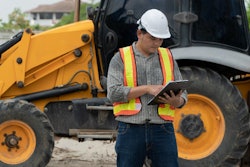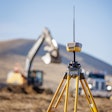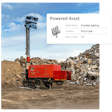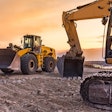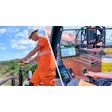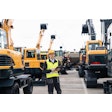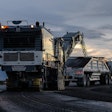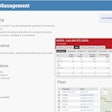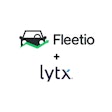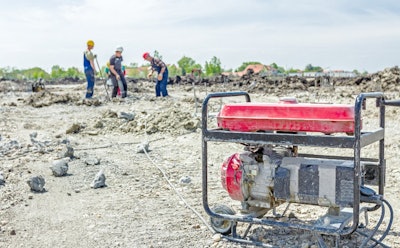
Contractors have equipment and tools, and these need to be tracked as they are assigned to employees and projects. Contractors running heavy equipment can choose from a number of robust, construction-specific GPS-enabled asset management software tools including Tenna, HCSS Equipment 360, Fleetio, Equipmentshare T3, Trackunit and others.
Trackunit, Tenna and other products also use Bluetooth Low-Energy (BLE) to track smaller items that do not have a power supply required by a more powerful telematics unit—including equipment attachments. But apart from partnerships between asset management software vendors like Trackunit and hand power tool manufacturers like Hilti, the GPS-Enabled Asset Management category in IronPros is aimed at companies with at least some heavy equipment. So why exactly are we talking about Asset Panda?
Asset Panda, the Frisco, Texas-based asset tracking and management software-as-a-service product is of interest to contractors because it comes in at a lower price point and address more non-equipment assets than software strictly used to track heavy equipment. Its core offering involves barcode generation, asset tags and a configurable software layer to tag and track a broad spectrum of assets. There has been GPS integration in the solution in that as an asset tag is scanned, the mobile device records the location at that moment, but there has been no live visibility of location or other asset data in real time.
The software is highly configurable for unique business workflows, and users can assign assets to individuals, job sites or vehicles, kit assets together, follow internal or mandated business rules on how assets can be use and manage contracts with equipment vendors. There is basic asset depreciation and maintenance ticketing, management and tracking functionality including maintenance and warranty tracking too.
But is a barcode-scanning tool tracking of interest to a contractor perhaps more focused on heavier assets? Asset Panda is most widely used on IT assets, office furniture—that small asset tag affixed to your work laptop or under the guest chair in your office may be one of theirs. And would a contractor want to have two asset management systems—one for small office assets and another for heavy equipment like offroad vehicles or attachments? Well, it could be we are underestimating this technology, or at least where the product is headed.
Big changes afoot
Our IronPros Product Deep Dive debriefing with Asset Panda Vice President of Sales Aaron McAffee and Account Executive Tom Whitehead revealed the company will be moving up in terms of the size and complexity of assets they can track and the extent to which that information will be dynamic and driven from connected devices.
Asset Panda already has some construction customers who do get some equipment-related capability right out of the box. An equipment operator can scan a barcode to request service, with that request going automatically into the queue. Even as a 100-employee company, Asset Panda is a viable vendor for this tech, which is lightweight and easy to sell, implement and support. Its sales team of about six each in sales and customer success bring about 100 net new customers a month—a lot more per rep than a more expensive or complex solution. The company supports more than 4,000 customers using the software in 47 different languages and 63 countries globally. The solution frees up staff from non-value-added asset management chores and according to Asset Panda can deliver 800% return on investment (ROI) based on time savings alone—and not counting harder-to-measure metrics like asset loss prevention or maintenance process improvements.
Enhancing Asset Panda for construction
Construction is just one vertical for Asset Panda, but McCaffee and Whitehead say they will be doubling down in this space with new capabilities coming in Q3 2022 for construction equipment including GPS location intelligence and the ability to gather operating data from equipment including operating times, temperatures and speeds.
“We do have a GPS locator currently,” McAffee said. “We have got an autodiscovery device network feature that’s being launched and our live GPS will all be rolled out soon.”
Current functionality for geolocation is limited to capturing the location of a mobile device when a barcode is scanned, so this movement towards capturing live feed data from internet of things (IoT) devices on construction equipment is a significant evolutionary leap for Asset Panda. Fortunately, about 40 percent of the company’s employees sit in research and development.
“We are going to be the Salesforce of asset management, helping contractors manage the entire asset lifecycle from purchasing to selling the asset,” McAffee said. “We are going to live inside of the tech stack of organizations, integrate with their enterprise resource planning (ERP) like Netsuite or Microsoft Dynamics or SAP. We will tie in billing, purchasing and ticketing data into a holistic view from inception to end of life. We are going to accomplish a lot of this through integrations.”
The goal is to grow the base of customers in construction and grow the share of existing construction customers from primarily office assets and into production assets in the field.
“About 25% to 30% of our customers are in construction—but we do mostly IT assets—the majority are computers, tablets and things like that,” Whitehead said. “We do have a healthy number of requests to track tools, large construction equipment, all the way down to contractors that have a handful of employees, but they have tools they want to make sure they get back and they want to have visibility into.”
Asset Panda tech stack
Asset Panda is a software-as-a-service (SaaS) application hosted on Amazon Web Services. Determining whether it is multi-tenant, where customers share a single instance of the software in the cloud, is complicated. Multi-tenant SaaS is popular now with investors and software vendors alike because it can drastically reduce the cost of provisioning, supporting and evolving applications over time, which in turn leads to higher margin. Software vendors that have simply uplifted older, on-premise software to a cloud-hosted solution may be at a competitive disadvantage. So contractors doing due diligence on software will want to understand where their vendor is on this continuum towards multi-tenancy so they can avoid adopting technology that nearing the end of its lifecycle or a vendor that is likely to be acquired by a larger, more profitable one.
So what is Asset Panda? Well, that depends.
“A hosted solution is not a true SaaS,” McAffee said. “We are true SaaS—when updates are pushed out, they are moved to everyone. Some people will say we are hosted in the cloud, on a hosted private cloud network. But this is a true SaaS solution.”
Asset Panda is similar to heavy construction ERP vendor HCSS in that they both boast advanced single-tenant architectures. One characteristic of a multi-tenant SaaS is that users can add or reduce the number of user seats or licenses from inside the software rather than interacting with a sales rep. HCSS offers this capability and is not multi-tenant. The takeaway being that a cool enough single-tenant architecture can be hard to distinguish from a multi-tenant one where it really matters. These single tenancies are also engineered to be easy to maintain, and initiating an instance of the software for a customer is fairly automated.
But just to make things more confusing, Asset Panda does in fact offer multitenancy to managed services providers (MSPs) that resell the system to others. So a managed services provider can have a single instance and resell it to multiple of their own customers.
“We can create as many instances as we want for individual customers,” McAffee said. “But multi-tenant enables a managed services company to manage everything under one roof. We see the multitenancy being a need for the MSPs that manage networks and services for micro-SMB companies who cannot manage their own network.”
Integration will be of critical importance to Asset Panda to realize on its vision of broad support of construction assets, and the company has its own internal, dedicated integrations team. Integrations with Sage construction ERP products and Netsuite are coming in Q4 of 2022, according to McAffee. Others could follow at a fair clip based on customer demand.
The field-based portions of the growing Asset Panda construction solution will consist of mature hardware technologies supported by satellite connectivity.
“We do have the bar code scanning currently with barcode scanning,” McAffee said. “Live GPS, temperature, speeds coming Q3.”
“The application primarily uses gateways and Bluetooth low-energy (BLE) assets tags,” McAffee said. “The gateways are designed to transmit the data and the tags are what actually goes on to the asset—they may be larger or harness different types of technology based on the needs of the equipment. Some customers may need larger bandwidth and need to send more data in real time. In that case, we may use a different type of satellite versus a lower WAN type that only sends data every 5 minutes.”
Data can also enter the application automatically through integrations with tools that scan a local area network to discover connected devices.
“If a customer has Cisco Meraki, we can scan their network, pull in the data on connected assets and their serial numbers right into our portal,” McAffee said. “Jamf is another partner which services Apple products—if you have a lot of Apple products we can search those. And then we have Lansweeper, a device-agnostic integration that is released to market in August.”
Price and market
Even before the anticipated support for sensor data capture rolls out, Asset Panda is useful for a broad swath of the construction industry, making for a large addressable market.
“We do see specialty and general contractors, but more specialty because they have larger pieces of equipment and want to inspect, locate and track which jobs they are assigned to,” Whitehead said. “Occasionally, you can get organizations that have groupings of assets—a truck or van they want to be able to track.
For a small-to-medium business looking for asset management software, competitors are numerous, including freemium products like AssetTTiger to more robust solutions like AssetTrack or PanatrackerST that may support RFID or other data capture technologies or offer deeper functionality.
“We have lost opportunities to construction-specific software vendors—we are industry agnostic,” Whitehead said. “We track stuff no matter what that the stuff is. But for us, that configurability is the name of the game. If you want to track something in your business, we can track it.”
Asset Panda’s pricing model is based on the total number of assets being tracked rather than the number of users. As the number of assets increases, the per-asset price drops. The company does offer enterprise pricing for large enough organizations and asset portfolios. What this means is that a very small business with lots of assets can make Asset Panda work—putting it right up the alley of many trade contractors, surveying businesses, green industry contractors, environmental engineering firms and more. The pending addition of new data capture methods moves Asset Panda further into more equipment-intensive construction businesses.
Implementation involves a small scope of professional services, and customers can purchase an optional support package.
BOTTOM LINE: Asset Panda is interesting for contractors on a number of levels. As Asset Panda expands into new methods of data capture, contractors get a single asset management application for front office equipment assets and back-office IT assets. Many contractors running a few pieces of heavy equipment could make Asset Panda cost-effective by combining data capture from those pieces of equipment with vehicles, IT assets, tool and other assets. This is a stable, middle market company that has been in the market for 10 years, so if a risk-averse contractor wanted to configure a solution to meet their precise needs, Asset Panda is a fit. The company is agile enough to quickly standup new functionality and standard integrations with the likes of Procore, Autodesk Construction Cloud, Trimble Construction One and other applications of record should not pose a problem. Partnerships with one or more of the construction-focused integration platform-as-a-services like Ryvit or Agave may make sense to create compatibility across multiple construction solutions. Another huge opportunity for Asset Panda is the AEMP Telematics Standard, published as ISO 15143-3 by the International Standards Organization, which would enable Asset Panda to bypass their own sensor hardware and ingest data from the telematics unit provided by the original equipment manufacturer (OEM). Many power tools also come equipped with their own BLE telematics, and these may be available to Asset Panda either directly or through an integration with a platform like Trackunit’s Kin. Given McAffee’s direction, open standards and more connected devices in construction, Asset Panda will be fun to watch.



